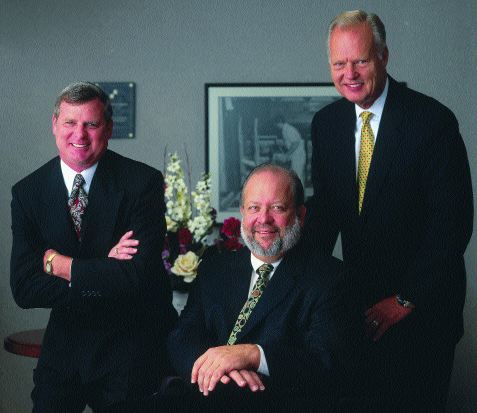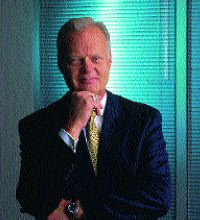

From left is the InsureTrade senior management team: Walter T. Wooten, vice president; Jeffrey A. Snider, founder and chairman; and DR Rawson, president.
It's a simple concept, but one that could revolutionize the way commercial lines insurance is written. It involves one of the most marvelous tools to come along since the personal computer:
the Internet.
This new Internet-based venture has the potential to change the way commercial insurance is handled. And don't worry, agents and brokers, you're still in the picture.
The company behind this new venture is Southern California-based InsureTrade.com. InsureTrade integrates all factors necessary to a fully serviced commercial insurance policy--the policyholder, the agency, and the insurance carrier that underwrites the risk.
InsureTrade also provides a permanent method of documentation for all communications among the parties in its secure database messaging system. The process is all tied into one Internet-based software system through which the users communicate and transact business.
Based in the sprawling urbanization of Santa Ana, in Orange County about 45 miles south of downtown Los Angeles and near Orange County's John Wayne International Airport, InsureTrade.com was launched September 18, 2000. However, it moved into its current 12,000 square foot office space in May 2000, in preparation for its launch.
The quickly growing corporation has three senior management visionaries guiding it. They are Jeff Snider, the founder and chairman;
DR Rawson, the non-insurance, entrepreneurial-experienced president; and Walter Wooten, the insurance industry-experienced
vice president.
Snider started in the insurance industry as a broker trainee with Swett & Crawford in Los Angeles' Wilshire district in 1973. He took time off during his junior year at Harvard University to, as he says, "make money," finally finishing at Harvard and going to work back on mid-Wilshire for one of Swett & Crawford's clients, Pan American Underwriters, that specialized in farm and ranch business. He later had a hand in starting Paula Insurance Company in 1975 and is still affiliated with the carrier which specializes in workers comp for agribusiness. "I feel bi-cultural," Snider says, "in that I understand the battle that often takes place between marketing and underwriting inside an insurance organization. They are two very different things that are intrinsically connected."
Snider has managed in both marketing and underwriting and says that is where some of his insights for InsureTrade's design came from. "I saw both sides and realized the functionality is mapped to these," Snider said. "Here, both worlds are brought together."
 "The InsureTrade process supports providing a risk profile ... to assure that the risk is priced right."
"The InsureTrade process supports providing a risk profile ... to assure that the risk is priced right."
--DR Rawson
Rawson's role was to be the outside entrepreneurial visionary and non-insurance voice of reason in the start-up, design and launch.
"Bringing this all together has been interesting to me, from an entrepreneurial standpoint, not being an insurance person," Rawson says. "The biggest single factor, and ultimately the most significant challenge in this industry, is the paperwork. How do we address that?"
As president, Rawson's responsibility was to get the company, corporate culture, business model, and software built. Essentially, the process began in June 1999, when the company started out with just the two founding employees. It grew quickly, too, from 144 square feet of office space to 1,900 square feet, to the now 12,000 square feet. Recalling the development process, Rawson refers to its start as "BBs in a boxcar with rapid growth developing from two founding managers to the now 55 employees."
 Jeff Snider points out that InsureTrade is building infrastructure, not regulating business. "We're in business to make things easier."
Jeff Snider points out that InsureTrade is building infrastructure, not regulating business. "We're in business to make things easier."
Wooten has been in the insurance business since 1972, working in retail firms, wholesalers, as a surplus lines broker, company underwriter and running company underwriting departments. Snider's desire to add Wooten to his upper-management staff is founded in the fact that Wooten has known him and worked side-by-side with him for a long time. Snider says that Wooten understands insurance operations and has a unique advantage in understanding independent agents, wholesalers, underwriters, and marketers.
InsureTrade seeks to make communication instantaneous, finding ways to handle the sometimes cumbersome communication process of commercial insurance more quickly and efficiently. And, Wooten emphasizes, InsureTrade's business plan is based on a thorough understanding of the commercial insurance transaction and culture that goes with it--including all the human interaction and the need for the agent/broker and underwriter to simply, as the Beatles put it, "come together."
 Walter Wooten says InsureTrade's trading floor concept uses a simple data point profile which enables the carrier to understand enough about the risk and the agent submitting the risk to request a full submission.
Walter Wooten says InsureTrade's trading floor concept uses a simple data point profile which enables the carrier to understand enough about the risk and the agent submitting the risk to request a full submission.
In short, InsureTrade views itself as a provider of communication between commercial independent agents/brokers and insurance carriers. If it sounds like a simple concept that's because it really is.
Snider has been a broker or underwriter his entire insurance career. So why did he decide to go down this path? Where was the InsureTrade vision born? Snider answers those questions by explaining what were not among the reasons for starting this dot-com business.
"I didn't do it to exploit enhancements of technology in order to bring new efficiencies to the industry," Snider says. "I did it because I'm an insurance guy, and I saw the Internet as a compelling mode for moving around. It is not a 'destination' and not a proxy for interacting with people. With all the interest in the Internet, I'd never heard any of my customers say, 'Hey, Jeff, if I could buy my insurance on the Internet that would be cool.' What they said was more like, 'If I could communicate with you on the Internet that would be great.'"
When Snider and the other executives started visiting agencies, they got validation for the concept. In one instance, an agency customer service representative said, "Yeah, this [process] is cool!" Snider says that this reaction from the CSR means, "InsureTrade is a winner, because generally if the CSRs are happy with the methods of doing business, then the principals are happy. And if the company underwriters like this process, I feel safe."
InsureTrade improves the commercial insurance process by providing platform processes: it is reducing processing time, increasing submission accuracy, opening new markets to agencies and underwriters, and integrating seamlessly into agency/carrier workflow by cutting communication costs, boosting revenues, and preserving and even building traditional relationships.
InsureTrade uses database messaging which is essentially a platform or standard of communication that uses InsureTrade software on an Internet-based system to overcome the shortfalls of faxing or e-mail.
Second, InsureTrade has a trading floor that allows risks to be presented (in theory to the masses of carriers using the system), in great detail, with all necessary information, that can be seen by several carriers that may be interested in viewing it from an underwriting perspective.
Wooten refers to the process of shopping a commercial risk as somewhat like a verbal dance. A customer service representative or agency underwriter might have a risk with a loss history problem. There's concern that everyday markets might not respond to it. The trading floor concept allows several sets of underwriting eyes with varying appetites to see it, view it, and ultimately respond. When the underwriter finds a risk on the trading floor that matches the company's risk appetite, the underwriter has the opportunity to request more information (i.e., applications and supporting documentation) with one mouse click. The agency will then provide the information necessary so that an underwriting decision can occur.
Wooten describes the trading floor as, "The opportunity for underwriters (carriers) to find submitted risks that match their appetite. Using a simple data point profile, the carrier is able to understand enough about the risk and the agent submitting the risk to request a full submission."
Third in the mix is InsureTrade's FloMagnet, a proprietary license that offers carriers, general agents and agencies specialty programs to the general risk marketplace.
And, fourth but not least, is InsureTrade's policyholder marketing tool, which combines a high-touch element into high-tech communication with a special feature for commercial policyholders. Producers and CSRs can use this personalized tool to create a secure link between the policyholder and agent. All communications are journalized, time-stamped, and third-party archived, which ultimately reduces errors and omissions exposures for the agent/broker.
In the commercial insurance application process, Wooten says, InsureTrade's being an ACORD-based company is beneficial to the agents. "Agents need to be able to condense and present the data to determine what coverages are necessary and at what attachment points, and as limits are created and negotiated."
InsureTrade does business by approaching independent agents and brokers, explaining its business model. The agent or broker then decides if InsureTrade can offer value and efficiencies that are useful for him/her. "The agents tell us what companies they want to do business with and have relationships with," Wooten says. "We get agreements from those underwriting companies to accept business from the agents through our system. In all cases, those two already have a relationship."
What is important to InsureTrade's platform and approach is the fact that those relationships and connections multiply by allowing compilation of the risk. This compilation can include the ACORD form, profit and loss statement, loss runs, supplemental applications, photographs and/or Microsoft Excel attachments--all into one point within the InsureTrade system. The risk can then be submitted consistently, so the agent can communicate with one underwriter at one carrier, several underwriters within that carrier, or several carriers to find a home for the risk.
Any underwriter at any carrier can simply pull up all this risk information to his/her desktop computer, review it, pose underwriting questions, and simply reply to it in a form that looks something like a standardized e-mail. The originating agency can respond and the communication circle is complete.
All records of communication are kept online for 13 months, and finally backed up onto DVD after that. There are no lost telephone call records, faxes that didn't go through, and all communication is date stamped with time sent, time received, and time read.
In this paper-dependent industry, InsureTrade has yet, in its short lifetime, to be involved in having to produce court-ready documents in the event of litigation between third parties. There have been no disputes or coverage validations required. However, it will happen, given enough time. Wooten says InsureTrade's documentation process is based on technology that courts recognize, that once documentation is created, it cannot be altered, and that InsureTrade believes the courts will accept the documentation even if discovery must be done.
InsureTrade staff has quickly grown to its 55 employees, adding staff at a significant rate to support the $1.2 billion in EAP that committed agencies might flow through InsureTrade. Referring to the $1.2 billion figure, Wooten says, "We see that as market acceptance."
In its initial launch, InsureTrade has primarily focused its efforts in 13 major markets. InsureTrade has member agencies in 16 states.
The testing model that was designed was taken to some initial focus group agents in October 1999. Rawson says InsureTrade visited several agency principals, asking their opinions of the InsureTrade concept and also, "Would you participate in this business model?" "Many said yes, opting to write checks right on the spot that led to an initial commercial volume of $500 million within the first few weeks of its pre-launch sales effort."
Rawson explains that InsureTrade generates revenue based on connectivity. While initially focusing on the agency, fees are paid by either the agency or the carrier. Like the phone company only one of the parties pays for connectivity. This allows InsureTrade to remain an objective, impartial intermediary that provides the communication platform.
Like Wooten, Rawson focuses on the simplification of communication that the business model for InsureTrade addresses. On average, a typical commercial submission, he says, can be up to 100-plus pages including loss runs, the profit and loss statement and other documents.
"Our process supports providing a risk profile, getting the best information out there, to assure that the risk is priced right," Rawson adds. "If it is priced right, that means everyone in the value chain benefits. It is something underwriters and marketers have been looking for for a long time--that is, how do you keep the risk priced right?"
Snider describes InsureTrade as privately owned with capital features that are typical of many Internet start-ups. Many employees have incentive equity opportunities, and there is a small group of direct investors, with Snider being the significant one.
"I basically financed this thing, and we did institutional financing," Snider says. "One thing we haven't done is take any direct investments from insurance companies, so there is no dealing with perceived conflict. On the other side, there is no investment from brokers or agents either."
InsureTrade is in the business of building infrastructure as opposed to regulating business. Therefore it doesn't have to answer to various state insurance departments, with Snider saying, "We're in business to make things easier and enforce best practices."
The author
Brett Hanavan is a San Diego, California-based freelance journalist who has worked in the insurance industry for 13 years. He is a former staff writer for Insurance Journal West.
For more information
InsureTrade.com
Santa Ana, California
Contact: Helen Boyd, Vice President of Communications
E-mail: helen.boyd@insuretrade.com
Web site: www.insuretrade.com